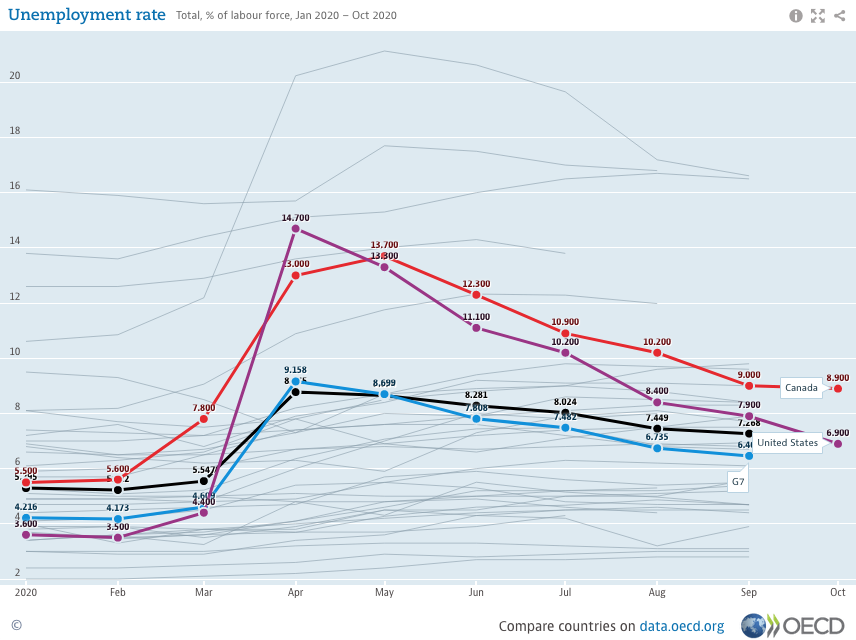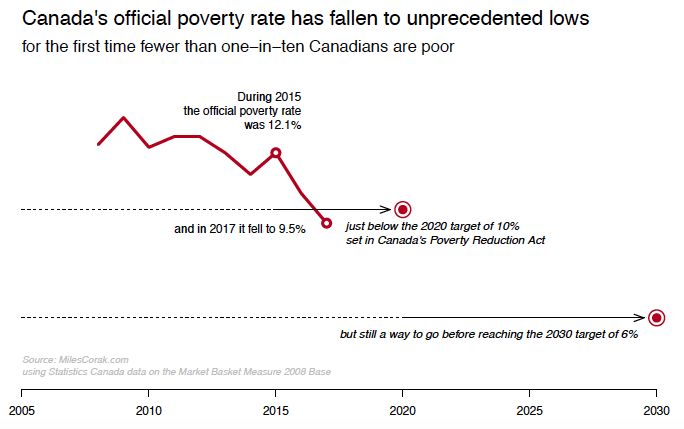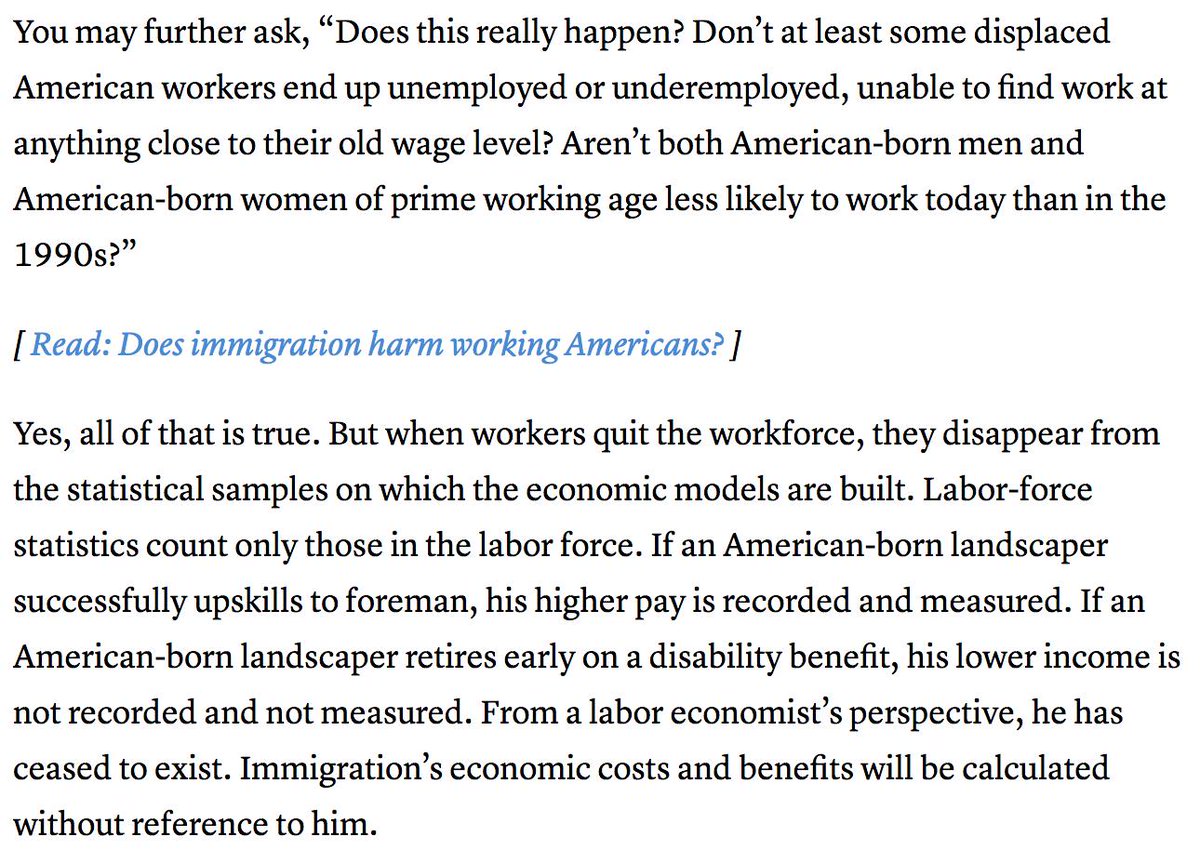
Ahh, one of those teachable moments.
Let's talk unemployment rates!
Here's what appears to be @OECD source for these @PierrePoilievre statements, which refer to September 2020 unemployment rates
(9 % for Canada and 7.9 % for US)
data.oecd.org/chart/6a2P
#cdnecon #EconTwitter
Let's talk unemployment rates!
Here's what appears to be @OECD source for these @PierrePoilievre statements, which refer to September 2020 unemployment rates
(9 % for Canada and 7.9 % for US)
data.oecd.org/chart/6a2P
#cdnecon #EconTwitter
https://twitter.com/PierrePoilievre/status/1326860488374951939
The October @OECD numbers for Canada and the US are 8.9% ad 6.9%, but interestingly note that @StatCan_eng reports 8.7% and @BLS_gov reports 6.9%
#cdnecon #EconTwitter
#cdnecon #EconTwitter

.@OECD is great for getting comparable statistics, and the unemployment rate is both an important headline indicator but also a tricky one because there are differences in how accepted definitions are operationalized by different statistical agencies
#cdnecon #EconTwitter
#cdnecon #EconTwitter
These differences don't usually amount to much, but that may not be the case during #COVID19. @OECD warns that Canada and the US treat those on temporary layoff differently than the European statistical agencies.
#cdnecon #EconTwitter
#cdnecon #EconTwitter
.@StatCan_eng and @BLS_gov are more likely to classify individuals on temporary layoff as unemployed, but in Europe they are more likely to be considered employed
oecd.org/sdd/labour-sta…
#cdnecon #EconTwitter
oecd.org/sdd/labour-sta…
#cdnecon #EconTwitter
This may be why Canadian and US unemployment rates may be reported to be higher than countries like Germany, France, and the UK.
But we're still left with a big gap between Canadian and US unemployment rates, arguably the most important comparison.
#cdnecon #EconTwitter
But we're still left with a big gap between Canadian and US unemployment rates, arguably the most important comparison.
#cdnecon #EconTwitter
Here again there are subtle statistical differences that matter in making comparisons. I offered an explainer in 2012, see this post on my web site:
milescorak.com/2012/05/04/the…
#cdnecon #EconTwitter
milescorak.com/2012/05/04/the…
#cdnecon #EconTwitter
Long ago @StatCan_eng addressed the need to make Canada-US comparisons and calculated a Canadian unemployment rate using US statistical methods.
You can access it here:
www150.statcan.gc.ca/t1/tbl1/en/tv.…
#cdnecon #EconTwitter
You can access it here:
www150.statcan.gc.ca/t1/tbl1/en/tv.…
#cdnecon #EconTwitter
The bottom line?
In October 2020 the official Canadian unemployment rate was 8.7% and when adjusted to US standards was 7.1%, which was essentially the same as the official US rate of 6.9%.
#cdnecon #EconTwitter
In October 2020 the official Canadian unemployment rate was 8.7% and when adjusted to US standards was 7.1%, which was essentially the same as the official US rate of 6.9%.
#cdnecon #EconTwitter
In September, the time period @PierrePoilievre used, the Canadian unemployment according to US definitions was 7.3%, actually a bit lower than the 7.9% prevailing in the US.
#cdnecon #EconTwitter
#cdnecon #EconTwitter
Generally the Canadian unemployment rate is higher than the US unemployment even when statistical differences are corrected. In February 2020 the US unemployment rate stood at 3.5%, the comparable Canadian at 4.7%.
#cdnecon #EconTwitter
#cdnecon #EconTwitter
The fact that the Canadian unemployment rate is now in the range of the US numbers, and even lower, suggests we are doing better, just the opposite of the conclusion @PierrePoilievre was suggesting.
#cdnecon #EconTwitter
#cdnecon #EconTwitter
Numbers don't lie, and we don't have to torture them, but we do have to bring care to interpreting them to appreciate their truths.
#cdnecon #EconTwitter
#cdnecon #EconTwitter
I hope this thread helps Parliamentarians to focus on that truth, but that said ... maybe in these times the unemployment is not even the best headline statistic to focus upon.
But that's another story for the next teachable moment.
#cdnecon #EconTwitter
But that's another story for the next teachable moment.
#cdnecon #EconTwitter
• • •
Missing some Tweet in this thread? You can try to
force a refresh





